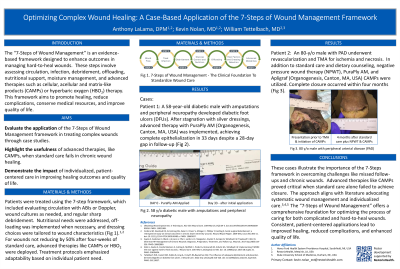Evidence-Based Practice
(EBP-012) Optimizing Complex Wound Healing: A Case-based Application of the 7-steps of Wound Management Framework
Friday, May 2, 2025
7:45 PM - 8:45 PM East Coast USA Time

William Tettelbach, MD, FACP, FUHM, FIDSA, MAPWCA – Chief Medical Officer, Wound Care & Hyperbaric Medicine, RestorixHealth, Metairie, LA; Kevin Nolan, MD – Regional Medical Director, Wound Care & Hyperbaric Medicine, RestorixHealth, Metairie, LA
Introduction:
The "7-Steps of Wound Management" is an evidence-based framework designed to enhance outcomes in managing hard-to-heal wounds. These steps involve assessing circulation, infection, debridement, offloading, nutritional support, moisture management, and advanced therapies such as CAMPs or hyperbaric oxygen (HBO2) therapy. This framework aims to promote healing, reduce complications, conserve medical resources, and improve quality of life. The objective of highlighting this case-based application of the 7-Steps of Wound Management Framework was to:
· Evaluate the application of the 7-Steps of Wound Management framework in treating complex wounds through case studies,
· Highlight the usefulness of advanced therapies, like CAMPs, when standard care fails in chronic wound healing,
· Demonstrate the impact of individualized, patient-centered care on improving healing outcomes and quality of life.
Methods: Patients were treated using the 7-step framework, which included evaluating circulation with ABIs or Doppler ultrasound, wound cultures as needed, and regular sharp debridement. Nutritional needs were addressed, off-loading was implemented when necessary, and dressing choices were tailored to wound characteristics (Fig 1).[1,2,3] For wounds not reducing by 50% after
four-weeks of standard care, advanced therapies like CAMPs or HBO2 were deployed. Treatment protocols emphasized adaptability based on individual patient needs.
Results:
Patient 1: A 58-year-old diabetic male with amputations and peripheral neuropathy developed diabetic foot ulcers. After stagnation with silver dressings, advanced therapy with PuraPly was implemented, achieving complete closure in 33 days despite a 28-day gap in follow-up (Fig 2).
Patient 2: An 80-year-old male with PAD underwent revascularization and TMA for ischemia and necrosis. NPWT, dietary counseling, PuraPly AM, and Apligraf CAMPs were utilized. Complete closure occurred within four months (Fig 3).
Discussion: These cases illustrate the importance of the 7-Steps framework in overcoming challenges like missed follow-ups and chronic wounds. Advanced therapies like CAMPs proved critical when standard care alone failed to achieve closure. The approach aligns with literature advocating systematic wound management and individualized care. [4,5,6] The "7-Steps of Wound Management" offers a comprehensive foundation for optimizing chronic wound care. Consistent, patient-centered application leads to improved healing, reduced complications, and enhanced quality of life.
The "7-Steps of Wound Management" is an evidence-based framework designed to enhance outcomes in managing hard-to-heal wounds. These steps involve assessing circulation, infection, debridement, offloading, nutritional support, moisture management, and advanced therapies such as CAMPs or hyperbaric oxygen (HBO2) therapy. This framework aims to promote healing, reduce complications, conserve medical resources, and improve quality of life. The objective of highlighting this case-based application of the 7-Steps of Wound Management Framework was to:
· Evaluate the application of the 7-Steps of Wound Management framework in treating complex wounds through case studies,
· Highlight the usefulness of advanced therapies, like CAMPs, when standard care fails in chronic wound healing,
· Demonstrate the impact of individualized, patient-centered care on improving healing outcomes and quality of life.
Methods: Patients were treated using the 7-step framework, which included evaluating circulation with ABIs or Doppler ultrasound, wound cultures as needed, and regular sharp debridement. Nutritional needs were addressed, off-loading was implemented when necessary, and dressing choices were tailored to wound characteristics (Fig 1).[1,2,3] For wounds not reducing by 50% after
four-weeks of standard care, advanced therapies like CAMPs or HBO2 were deployed. Treatment protocols emphasized adaptability based on individual patient needs.
Results:
Patient 1: A 58-year-old diabetic male with amputations and peripheral neuropathy developed diabetic foot ulcers. After stagnation with silver dressings, advanced therapy with PuraPly was implemented, achieving complete closure in 33 days despite a 28-day gap in follow-up (Fig 2).
Patient 2: An 80-year-old male with PAD underwent revascularization and TMA for ischemia and necrosis. NPWT, dietary counseling, PuraPly AM, and Apligraf CAMPs were utilized. Complete closure occurred within four months (Fig 3).
Discussion: These cases illustrate the importance of the 7-Steps framework in overcoming challenges like missed follow-ups and chronic wounds. Advanced therapies like CAMPs proved critical when standard care alone failed to achieve closure. The approach aligns with literature advocating systematic wound management and individualized care. [4,5,6] The "7-Steps of Wound Management" offers a comprehensive foundation for optimizing chronic wound care. Consistent, patient-centered application leads to improved healing, reduced complications, and enhanced quality of life.

.jpg)